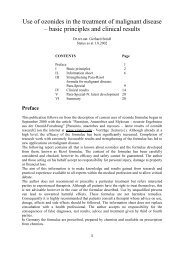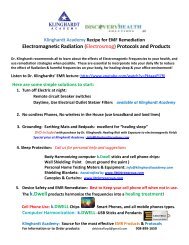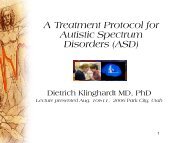Some Facts and Research on Using Color and Light for Healing
Some Facts and Research on Using Color and Light for Healing
Some Facts and Research on Using Color and Light for Healing
You also want an ePaper? Increase the reach of your titles
YUMPU automatically turns print PDFs into web optimized ePapers that Google loves.
Dietrich Klinghardt, MD, PhD<br />
Bellevue, WA<br />
www.neuraltherapy.com<br />
In the German speaking countries of Europe, color therapy through the eyes<br />
has become very popular in recent years am<strong>on</strong>gst alternative health<br />
practiti<strong>on</strong>ers <str<strong>on</strong>g>and</str<strong>on</strong>g> in spite of it’s American birthplace is more str<strong>on</strong>gly<br />
represented at alternative medical meetings in Europe then it is here in the<br />
US at this time.<br />
3 events were most instrumental to this rise in interest:<br />
1. The publicati<strong>on</strong> <str<strong>on</strong>g>and</str<strong>on</strong>g> success of Dr.Klinghardt’s German textbook <strong>on</strong><br />
holistic healing (see below)<br />
2. The inspired teaching of Steven Vasquez PhD, in Europe (originally<br />
facilitated by Dietrich’s book <str<strong>on</strong>g>and</str<strong>on</strong>g> ef<strong>for</strong>ts)<br />
3. The Phot<strong>on</strong>Wave color-instrument which was originally c<strong>on</strong>ceived by<br />
John Searfoss OD <str<strong>on</strong>g>and</str<strong>on</strong>g> is being manufactured under guidance of color<br />
therapist Le<strong>on</strong>a Vermeire in Belgium<br />
Here is an English translati<strong>on</strong> of 2 chapters of Dietrich’s book.<br />
<str<strong>on</strong>g>Some</str<strong>on</strong>g> <str<strong>on</strong>g>Facts</str<strong>on</strong>g> <str<strong>on</strong>g>and</str<strong>on</strong>g> <str<strong>on</strong>g>Research</str<strong>on</strong>g> <strong>on</strong> <strong>Using</strong> <strong>Color</strong> <str<strong>on</strong>g>and</str<strong>on</strong>g><br />
<strong>Light</strong> <strong>for</strong> <strong>Healing</strong><br />
translated from:<br />
“Lehrbuch der Psycho-Kinesiologie- ein neuer Weg in der psychosomatischen<br />
Medizin” (Textbook of Psycho-Kinesiology – a new approach in psychosomatic<br />
medicine)<br />
Dietrich K.Klinghardt, MD, PhD<br />
Verlag Hermann Bauer, Freiburg, Germany 1995<br />
During the 19th century the American surge<strong>on</strong>, E. Babbit, M.D. proved that<br />
treatment with colored light could achieve very significant healing results<br />
through its effect <strong>on</strong> the human energy field, the light receptive aut<strong>on</strong>omic<br />
nerve fibers in the skin <str<strong>on</strong>g>and</str<strong>on</strong>g> via the nerves that c<strong>on</strong>nect the eye directly with the<br />
limbic system i .<br />
In the beginning of this century the East Indian genius Darius Dinshah, who<br />
had immigrated into the USA, introduced a system of color therapy, that<br />
involves shining the color <strong>on</strong>to the body or body regi<strong>on</strong>s <strong>for</strong> about 1 hour/day.
The American physician Riley Spitler, M.D. proved in the 30’s that many<br />
patients with psychiatric illnesses could be cured or improved if the client<br />
looked into a specially designed colored lamp ii . He developed several<br />
instruments <str<strong>on</strong>g>and</str<strong>on</strong>g> started the science of “synt<strong>on</strong>ic optometry”. He found that the<br />
optimum treatment time is twenty minutes a day <strong>for</strong> a course of twenty days.<br />
This should be followed by a pause of several weeks be<strong>for</strong>e another twenty-day<br />
cycle. He achieved impressive healings in patients with bipolar disorder,<br />
schizophrenia, depressi<strong>on</strong> <str<strong>on</strong>g>and</str<strong>on</strong>g> other psychiatric disorders iii iv .<br />
<strong>Color</strong>ed light - when beamed into the eyes with a projector-like device – can<br />
activate repressed memories from childhood - even from the intrauterine period<br />
or from a past life - which may now become available to work with in a<br />
psychotherapeutic way v . In terms of modern neurophysiology we know now<br />
that distinct color frequencies can reactivate synapses in the brain vi vii which<br />
were previously blocked. If nerve c<strong>on</strong>ducti<strong>on</strong> is reestablished in these areas,<br />
memories which were isolated, are rec<strong>on</strong>nected with the synaptic network of<br />
the brain <str<strong>on</strong>g>and</str<strong>on</strong>g> can again be accessed <str<strong>on</strong>g>and</str<strong>on</strong>g> integrated by the c<strong>on</strong>scious part of the<br />
brain. The detrimental effect of unremembered trauma <strong>on</strong> the body seems to<br />
lastingly <str<strong>on</strong>g>and</str<strong>on</strong>g> often completely disappear.<br />
Memories c<strong>on</strong>nected to a physical or emoti<strong>on</strong>al trauma are held by circuitries in<br />
the limbic system, especially in the hippocampus <str<strong>on</strong>g>and</str<strong>on</strong>g> amygdala. These<br />
memories can be accessed with the correct color wavelength (<strong>for</strong> example, by<br />
using colored glasses). The exact color accesses the patient’s problem – just<br />
like accessing a hidden file in the computer. Recommended treatment time with<br />
color glasses is 1hr per day. However, worn in a therapeutic sessi<strong>on</strong>, a few<br />
minutes can be sufficient. The effect can be amplified by projecting light with<br />
an instrument into the eyes, <str<strong>on</strong>g>and</str<strong>on</strong>g> modulating the light with flicker frequencies viii .<br />
Several “synt<strong>on</strong>ic” instruments with <str<strong>on</strong>g>and</str<strong>on</strong>g> without frequency modulati<strong>on</strong> are<br />
available today. The effect can also be amplified <str<strong>on</strong>g>and</str<strong>on</strong>g> deepened by<br />
simultaneously using eye movements (example: Applied Psych<strong>on</strong>eurobiology)<br />
<str<strong>on</strong>g>and</str<strong>on</strong>g>/or tapping techniques (example: Mental Field Therapy). The quality of the<br />
light source (light bulb), the color filters <str<strong>on</strong>g>and</str<strong>on</strong>g> lens arrangements affect the<br />
therapeutic outcome. In our office we also use linear polarizati<strong>on</strong> filters at<br />
varying angles to reach more specific regi<strong>on</strong>s within the brain.<br />
I use the term “color coding of memories”. Memories are color-coded! Use the<br />
right code <str<strong>on</strong>g>and</str<strong>on</strong>g> the memory surfaces. To make the c<strong>on</strong>necti<strong>on</strong> to the repressed<br />
c<strong>on</strong>flict-material, the practiti<strong>on</strong>er has to determine the exact correct color.<br />
Spitler, just like Dinshah, spent much of his life determining which color
frequencies are needed to heal specific illnesses.<br />
Several methods of determining the correct color are available today.<br />
(1) Critical Flicker Fusi<strong>on</strong> Test<br />
(2) <strong>Color</strong> Visual Field Test<br />
(3) Luescher <strong>Color</strong> Test<br />
(4) Aut<strong>on</strong>omic Resp<strong>on</strong>se Testing (ART) – using muscle-t<strong>on</strong>e biofeedback<br />
(5) Steve Vasquez (Ph.D.) method - assessing emoti<strong>on</strong>al resp<strong>on</strong>ses after color<br />
presentati<strong>on</strong><br />
(6) Heart Rate Variability<br />
(7) Kirlian Photography - used by Peter M<str<strong>on</strong>g>and</str<strong>on</strong>g>el’s color puncture practiti<strong>on</strong>ers)<br />
(8) Intuiti<strong>on</strong> <str<strong>on</strong>g>and</str<strong>on</strong>g> experience<br />
(9) using the known physiological effects of color:<br />
Blue – activates the parasympathetic nervous system.<br />
calms – often used <strong>for</strong> hyperactive children.<br />
Red – activates sympathetic nervous system.<br />
Blue-Green – heals post-traumatic tissue-injuries.<br />
Yellow – anti-depressive.<br />
Yellow/Green – liver detox.<br />
Magenta – brings deeply held c<strong>on</strong>flicts <str<strong>on</strong>g>and</str<strong>on</strong>g> emoti<strong>on</strong>s to the surface.<br />
Language is full of knowledge about the c<strong>on</strong>necti<strong>on</strong> of color <str<strong>on</strong>g>and</str<strong>on</strong>g> emoti<strong>on</strong>, <strong>for</strong><br />
example:<br />
He’s got the blues (blue slows us down <str<strong>on</strong>g>and</str<strong>on</strong>g> makes already slow people<br />
depressed)<br />
I am in a black mood (see discussi<strong>on</strong> <strong>on</strong> black below).<br />
She’s green with envy (envy is a liver emoti<strong>on</strong> <str<strong>on</strong>g>and</str<strong>on</strong>g> the correct color is<br />
yellow/green).<br />
Red-Hot love (red brings out emoti<strong>on</strong> in people – including sexual passi<strong>on</strong>)<br />
<strong>Color</strong>s can have two distinct - <str<strong>on</strong>g>and</str<strong>on</strong>g> often opposite - effects. Because of the<br />
color-coding of emoti<strong>on</strong>s, treatment with color can either trigger the expected<br />
color-typical physiological reacti<strong>on</strong> or, instigate the release of a related color<br />
coded emoti<strong>on</strong> or problem. Take blue light, <strong>for</strong> example. Blue light will usually<br />
have a sedative effect. However, if i.e. A young man had been molested by his<br />
mother when he was a young boy- <str<strong>on</strong>g>and</str<strong>on</strong>g> she was wearing a blue bra at the time -<br />
blue may cause sympathetic arousal (distress) in this man until the trauma is<br />
healed.<br />
The Neurophysiology of <strong>Light</strong>: the Five Pathways
1. The optic nerve travels from the retina, past the pituitary gl<str<strong>on</strong>g>and</str<strong>on</strong>g> via the<br />
temporal lobe to the occipital lobe of the brain. This part of the visual system is<br />
dedicated to in<strong>for</strong>ming the c<strong>on</strong>scious part of our brain of our surroundings.<br />
2. An additi<strong>on</strong>al nerve bundle is leading directly from the retina to the<br />
hypothalamus (retino-hypothalamic tract) ix . This explains the above menti<strong>on</strong>ed<br />
strictly physiological effect of color <strong>on</strong> the ANS:<br />
- Blue stimulates the anterior hypothalamus, which harbors the main regulating<br />
part of the parasympathetic nervous system. This means that all colors in the<br />
bluish spectrum - from blue/green through blue to violet – normally have a<br />
sedating, digesti<strong>on</strong>-activating, sleep-inducing effect.<br />
- Red simulates the posterior hypothalamus <str<strong>on</strong>g>and</str<strong>on</strong>g> there<strong>for</strong>e the sympathetic<br />
nervous system. Red provokes anger. All colors in the red spectrum - from<br />
magenta through red/orange to yellow - have a stimulating, sometimes even<br />
provocative, character.<br />
- Green mediates between both systems.<br />
3.A side-branch of this nerve tract reaches the amygdala directly, bypassing the<br />
hypothalamus. The two corpora amygdaloidea are truly the color sensitive area<br />
of the limbic system <str<strong>on</strong>g>and</str<strong>on</strong>g> highly resp<strong>on</strong>sive to the color the eyes are exposed to.<br />
A study dem<strong>on</strong>strated that each m<strong>on</strong>ochromatic color frequency excites<br />
specific neur<strong>on</strong>s. If adjacent, but dissimilar color-wavelengths are used, the<br />
same neur<strong>on</strong> stays unexcited x . Each frequency in the color spectrum there<strong>for</strong>e<br />
has its own specific neurological <str<strong>on</strong>g>and</str<strong>on</strong>g> psychological effect xi xii .<br />
The neurosurge<strong>on</strong>, Norman Shealy, M.D.,PhD – discoverer <str<strong>on</strong>g>and</str<strong>on</strong>g> inventor of<br />
TENS (Transcutaneous Electric Nerve Stimulati<strong>on</strong>) <str<strong>on</strong>g>and</str<strong>on</strong>g> developer of electric<br />
spinal chord stimulati<strong>on</strong>, c<strong>on</strong>ducted a study investigating biochemical changes<br />
in the brain after beaming different colors into the eye (using a synt<strong>on</strong>ic<br />
instrument called “Lumatr<strong>on</strong>”). Remarkable changes were evident in the<br />
c<strong>on</strong>centrati<strong>on</strong> of neurotransmitters in the cerebro-spinal fluid: norepinephrin,<br />
serot<strong>on</strong>in, beta-endorphin, cholinesterase, melat<strong>on</strong>in, oxytocin, growthhorm<strong>on</strong>e,<br />
LH, prolactin <str<strong>on</strong>g>and</str<strong>on</strong>g> progester<strong>on</strong>e xiii . These results explain why the<br />
treatment with color projecti<strong>on</strong> into the eye can have a profound effect <strong>on</strong> the<br />
horm<strong>on</strong>al system, the emoti<strong>on</strong>s, stress levels, sleep, brain functi<strong>on</strong>, <str<strong>on</strong>g>and</str<strong>on</strong>g> many<br />
other aspects of the patient’s biochemistry <str<strong>on</strong>g>and</str<strong>on</strong>g> well-being. The profound effect<br />
of light stimulati<strong>on</strong> to the retina <strong>on</strong> the body’s metabolism has l<strong>on</strong>g been<br />
established through the work of the brilliant German ophthalmologist Fritz<br />
Hollwich, M.D., Ph.D. xiv .<br />
4. A fourth nerve c<strong>on</strong>necti<strong>on</strong> from the retina follows the lower optic tract,<br />
which is not used <strong>for</strong> visi<strong>on</strong> <str<strong>on</strong>g>and</str<strong>on</strong>g> reaches the transpeduncular nucleus in the<br />
midbrain xv . This nucleus is also light <str<strong>on</strong>g>and</str<strong>on</strong>g> color sensitive xvi . From here the<br />
signal travels via the superior cervical gangli<strong>on</strong> back via the brainstem to the
pineal gl<str<strong>on</strong>g>and</str<strong>on</strong>g>. This pathway is – am<strong>on</strong>gst other less understood functi<strong>on</strong>s –<br />
resp<strong>on</strong>sible <strong>for</strong> the circadian day-night rhythm <str<strong>on</strong>g>and</str<strong>on</strong>g> the melat<strong>on</strong>in producti<strong>on</strong> in<br />
the pineal gl<str<strong>on</strong>g>and</str<strong>on</strong>g> when it gets dark xvii . This pathway has been given much<br />
attenti<strong>on</strong> lately in research c<strong>on</strong>cerning the treatment of seas<strong>on</strong>al affective<br />
disorder. Via sec<strong>on</strong>dary interneur<strong>on</strong>s all of these pathways are c<strong>on</strong>nected with<br />
each other <str<strong>on</strong>g>and</str<strong>on</strong>g> virtually each area of the brain.<br />
5. A fifth, <str<strong>on</strong>g>and</str<strong>on</strong>g> maybe most exciting way in which color finds it’s way inside the<br />
body, i.e. the subc<strong>on</strong>scious mind, the immune system, the limbic system, the<br />
nervous system etc - has <strong>on</strong>ly recently been discovered. There are more <str<strong>on</strong>g>and</str<strong>on</strong>g><br />
more scientific hints that light can charge particles that travel in the lymph <str<strong>on</strong>g>and</str<strong>on</strong>g><br />
blood as well as ax<strong>on</strong>ally inside the nerves xviii xix . <str<strong>on</strong>g>Research</str<strong>on</strong>g>ers at the University<br />
of Vienna, Austria, found that albumin is <strong>on</strong>e of the proteins able to be charged<br />
by colored light – <str<strong>on</strong>g>and</str<strong>on</strong>g> able to deliver this charge to tissues far away from the<br />
site of exposure. Through the outer layer of the skin light also affects pigments,<br />
fluorescent particles in the body fluids <str<strong>on</strong>g>and</str<strong>on</strong>g> inside the cells which travel in the<br />
blood <str<strong>on</strong>g>and</str<strong>on</strong>g> lymph. After being energized - in a color-wavelength <str<strong>on</strong>g>and</str<strong>on</strong>g> frequency<br />
specific way - they are transported to their target sites where the light-energy is<br />
discharged (116) xx . These light-discharges have an organizing <str<strong>on</strong>g>and</str<strong>on</strong>g> activating<br />
effect <strong>on</strong> cellular organelles <str<strong>on</strong>g>and</str<strong>on</strong>g> the cell metabolism in the target tissue (such as<br />
the brain or inner organs) xxi xxii xxiii .<br />
This mechanism explains partially the effects of color-treatment via the skin -<br />
including the Dinshah Method, Peter M<str<strong>on</strong>g>and</str<strong>on</strong>g>el’s <strong>Color</strong> Puncture <str<strong>on</strong>g>and</str<strong>on</strong>g> the effect<br />
which colors of clothing have <strong>on</strong> mood <str<strong>on</strong>g>and</str<strong>on</strong>g> the immune system. A study<br />
showed that wearing black clothing immediately depresses the NK-cell activity<br />
<str<strong>on</strong>g>and</str<strong>on</strong>g> several other parameters used to judge the activity of the immune system.<br />
Black is carcinogenic. The opposite is also true: wearing rainbow colors<br />
stimulates the immune system <str<strong>on</strong>g>and</str<strong>on</strong>g> the mood. A chiropractor in Santa Fe, who I<br />
worked with <strong>for</strong> years, treated many clients successfully <strong>for</strong> many severe<br />
illnesses - by having them paint their toenails in specific colors (which he<br />
determined be<strong>for</strong>e with a biofeedback method). Wearing nail polish proved to<br />
be a truly medical interventi<strong>on</strong> with many beneficial - <str<strong>on</strong>g>and</str<strong>on</strong>g> occasi<strong>on</strong>ally adverse<br />
- effects.<br />
The German scientist Fritz Albert Popp PhD c<strong>on</strong>firmed the prior research of<br />
Russian scientists <str<strong>on</strong>g>and</str<strong>on</strong>g> published many of his own papers, <strong>on</strong> the fact that all<br />
cells in an organism use subtle light emissi<strong>on</strong>s to communicate with each other<br />
c<strong>on</strong>stantly. Cells gossip, in<strong>for</strong>m, celebrate <str<strong>on</strong>g>and</str<strong>on</strong>g> grieve xxiv . Only cancer cells<br />
behave differently: they do not emit light. Recent research in stem cell therapy<br />
brought to light another astounding phenomen<strong>on</strong>: when cells are ill or in<br />
distress, they also give off “microscopic” sound signals. If the sound of a group<br />
of dying cells is artificially amplified, it sounds like a group of weeping <str<strong>on</strong>g>and</str<strong>on</strong>g>
grieving women. Injected stem cells (from embry<strong>on</strong>ic umbilical chords) follow<br />
this signal <str<strong>on</strong>g>and</str<strong>on</strong>g> settle in the area to lend their support. Stem cells are<br />
compassi<strong>on</strong>ate. Cells care <strong>for</strong> each other. When things go wr<strong>on</strong>g, such as in<br />
auto-immune diseases, they fight each other. <strong>Light</strong> (<str<strong>on</strong>g>and</str<strong>on</strong>g> sound) can have a<br />
profound effect <strong>on</strong> regulating <str<strong>on</strong>g>and</str<strong>on</strong>g> correcting inter-cellular communicati<strong>on</strong>s.<br />
I have been using color light therapy <strong>for</strong> 17 years in my medical practice<br />
specializing in the treatment of chr<strong>on</strong>ic pain <str<strong>on</strong>g>and</str<strong>on</strong>g> neuro-degenerative diseases<br />
with often astounding results. I have not observed any adverse effects, when the<br />
color <str<strong>on</strong>g>and</str<strong>on</strong>g> treatment protocol was properly selected. The teachings of the<br />
College of Synt<strong>on</strong>ic Optometry provided the safe <str<strong>on</strong>g>and</str<strong>on</strong>g> necessary foundati<strong>on</strong>.<br />
Summary: a growing body of research <strong>on</strong> the physiological effects of light<br />
supports our positi<strong>on</strong> <strong>for</strong> the medicinal use of light <str<strong>on</strong>g>and</str<strong>on</strong>g> color.<br />
i Babbit, E.: The Principles of <strong>Light</strong> <str<strong>on</strong>g>and</str<strong>on</strong>g> Colour: The <strong>Healing</strong> Power of Colour. 1878, Reprint, Secaucus<br />
N.J.: Citadel, 1976.<br />
ii<br />
Spitler, Riley: The Synt<strong>on</strong>ic Principle. Eat<strong>on</strong> Pub.: Ohio 1941. Nachdruck erhaltlich durch “College of<br />
Synt<strong>on</strong>ic Ophthometry ,” 4221 Warren Ave., Sacramento, Cal. 95822-1048.<br />
iii<br />
Liberman, Jacob: Die Heilende Kraft des Lichts. Der EinfluB des Lichts auf Psyche und Korper. Bern,<br />
1995.<br />
iv<br />
Ott, John: Health <str<strong>on</strong>g>and</str<strong>on</strong>g> <strong>Light</strong>. The Effects of Natural <str<strong>on</strong>g>and</str<strong>on</strong>g> Artificial <strong>Light</strong> <strong>on</strong> Man <str<strong>on</strong>g>and</str<strong>on</strong>g> Other Living Things,<br />
Columbus, Ohio: Ariel, 1973.<br />
v Liberman Jacob: Die Heilende Kraft des Lichts. Der EinfluB des Lichts auf Psyche und Korper. Bern<br />
1995.<br />
vi Neilsen, T.: Affect Desensitizati<strong>on</strong>: A Possible Functi<strong>on</strong> of REMs in Both Walking <str<strong>on</strong>g>and</str<strong>on</strong>g> Sleeping States.<br />
In: Sleep <str<strong>on</strong>g>Research</str<strong>on</strong>g>, 20, 1991, S. 10.<br />
vii<br />
Ringo, J. et al.: Eye Movements Modulate Activity in Hippocampal, Parahippocampal, <str<strong>on</strong>g>and</str<strong>on</strong>g><br />
Inferotemporal Neur<strong>on</strong>s. In: Journal of Neurophysiology, 71, 1994, S. 1-4.<br />
viii<br />
Bari<strong>on</strong>uevo, G. u.a.: The Effects of Repetitive Low-Frequency Stimulati<strong>on</strong> C<strong>on</strong>trol <str<strong>on</strong>g>and</str<strong>on</strong>g> “Potentiated”<br />
Synaptic Resp<strong>on</strong>ses in the Hippocampus. In: Life Sciences, 27, 1980, S. 2385-2390.<br />
ix<br />
Moore, R.: Visual Pathways <str<strong>on</strong>g>and</str<strong>on</strong>g> the Central Neural C<strong>on</strong>trol of Diurnal Rhythms. The<br />
Neurosciences 3 rd Study Program, Cambridge, Mass.: MIT, 1974.<br />
x<br />
Hill, R.: Single Cell Resp<strong>on</strong>se of the Nucleus of the Trans-Peduncular Tract in Rabbit to M<strong>on</strong>ochromatic<br />
<strong>Light</strong> <strong>on</strong> the Retina. In: Journal of Neurophysiology, Vol. 26.<br />
xi<br />
Birrin, F.: <strong>Color</strong> Psychology <str<strong>on</strong>g>and</str<strong>on</strong>g> <strong>Color</strong> Therapy. Secaucus, N.J.: Citadel, 1978.<br />
xii<br />
Toupin, A.: Photic Avtivati<strong>on</strong> <str<strong>on</strong>g>and</str<strong>on</strong>g> Experimental Data C<strong>on</strong>cerning <strong>Color</strong>ed Stimuli. In: Neurology<br />
(Minneap.), 16, 1966, S. 269<br />
xiii<br />
Shealy, Norman: Effects of the Lumatr<strong>on</strong> up<strong>on</strong> Neurochemicals. Lecture given <strong>for</strong> Dr. Shealy by Dr.<br />
Klinghardt at the 6 th Int.Rehab. Med. Ass. C<strong>on</strong>gress, Madrid, Spain, 1990.<br />
xiv<br />
Hollwich, F.: The Influence of Ocular <strong>Light</strong> Percepti<strong>on</strong> <strong>on</strong> Metabolism in Man <str<strong>on</strong>g>and</str<strong>on</strong>g> in Animal. Berlin,<br />
1985.<br />
xv<br />
Wurtman, R.: The Effects of <strong>Light</strong> <strong>on</strong> the Human Body. In: Scientific American, July 1975, Vol. 233, Nr.<br />
1, S. 68-79.<br />
xvi Hill, R.: Single Cell Resp<strong>on</strong>ses of the Nucleus of the Trans-Peduncular Tract in Rabbit to<br />
M<strong>on</strong>ochromatic <strong>Light</strong> <strong>on</strong> the Retina. In: Journal of Neurophysiology, Vol. 26.
xvii Wurtman, Richard u.a.: The Medical <str<strong>on</strong>g>and</str<strong>on</strong>g> Biological Effects of <strong>Light</strong>. In: Annals of the New York<br />
Academy of Sciences, Vol. 453, 1985<br />
xviii Hebeda, K.: <strong>Light</strong> Propagati<strong>on</strong> in the brain Depends <strong>on</strong> Nerve Fiber Orientati<strong>on</strong>, In: Neurosurgery, 35,<br />
1994, S. 720-724.<br />
xix Popp, Fritz A.: Biophot<strong>on</strong>en. Ein neuer Weg zur Losung des Krebsproblems. Heidelberg, 2. Aufl. 1984.<br />
xx Grass, F.: Biophot<strong>on</strong>s, CNS <str<strong>on</strong>g>and</str<strong>on</strong>g> the Possible Role of Pigments <str<strong>on</strong>g>and</str<strong>on</strong>g> Fluorescent Substances. Biological<br />
Effects of <strong>Light</strong> Symposium, Atlanta, Georgia, Okt. 1995.<br />
xxi Szent-Gyorgyi, A.: Introducti<strong>on</strong> to a Submolecular Biology. Academic Press: N. Y., 1960.<br />
xxii Szent-Gyorgyi, A.: Bioelectrics. Academic Press, N.Y.: New York, 1968.<br />
xxiii Hollwich, F.: The Influence of Ocular <strong>Light</strong> Percepti<strong>on</strong> <strong>on</strong> Metabolism in Man <str<strong>on</strong>g>and</str<strong>on</strong>g> Animal. Berlin,<br />
1985.<br />
xxiv Popp, Fritz A.: Biophoten. Ein Neuer Weg zur Losung des Krebsproblems. Heidelberg, 2. Aufl. 1984.








